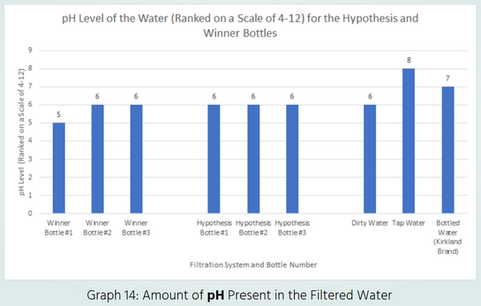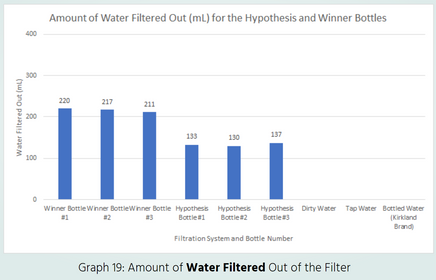Investigating the Importance of Water Filtration: Water, Water Everywhere and Not a Drop to Drink!
- sarahnoorjamani
- Aug 10, 2023
- 16 min read

Table of Contents:
Background Research:
What is the Importance of Clean Water? - A Global Challenge

Although over 70 percent of the Earth is covered with water, only about 3 percent of the Earth's water is freshwater. Of that, only about 1.2 percent can be used as drinking water. Over half of the world’s hospital beds are filled with people suffering from a water related disease. In developing countries, about 80% of illnesses are linked to poor water and sanitation conditions. One out of every 5 deaths to persons under the age of 5 worldwide is due to a water-related disease. Clean water that is safe to drink is critical to healthy living.
Many water sources contain pollution of some form, whether it is bacteria and microorganisms, chemicals, toxins, waste, litter, or other substances and materials. Water in lakes, rivers and swamps often contain impurities and bacteria. The water may also contain other microbiological organisms that can cause disease.
What Process can be Used to Clean Drinking Water?
Filtration is the process in which solid particles in a liquid or gaseous fluid are removed by the use of a filter medium that permits the fluid to pass through but retains the solid particles.
Each layer of a water filter has a purpose. Gravel or pebbles are used to filter out large sediments like leaves or insects. Sand is used to remove fine impurities. The activated charcoal removes contaminants and impurities through chemical adsorption.
Adsorption occurs when compounds stick to the carbon surface. The forces that exist between molecules or particles can be attractive or repulsive. This is why the surface area of the activated carbon matters. The more surface area, the more possible bonding sites there are for contaminants. If all the bonding sites are taken up, then the impurities remain in the water.
What Materials Can be Used to Clean Drinking Water?
Filtration is critically important and in my project I will learn about filtration and how I can turn polluted water into clean water using commonly found materials. I will determine which materials have the greatest ability to filter out dirt, silt and sediment from the contaminated water and use this knowledge to design a filtration system and test it against my hypothesis.
Purpose:
The purpose of this experiment was to test the effectiveness of filtration materials and analyze the data collected to use this information to work toward an improved filtration device.
Questions:
What effect do the filtration materials have on the quantity of water that is filtered (mL)?
What effect do the filtration materials have on the pH of the water?
What effect do the filtration materials have on the total amount of chlorine, copper, nitrates, nitrites, alkalinity, hardness, iron and Total Dissolved Solids (TDS) present in the water?
Overall Question:
Which filtration system will filter the polluted water the best and remove the most amount of contaminants so that the water will be drinkable.
Hypothesis and Variables:
Hypothesis: If I use a testing procedure to effectively test which filter materials are the most effective then the best filter design will have cotton balls, powdered activated charcoal, fine sand, and small pebbles because these materials have the greatest ability to filter out dirt, silt and sediment from the contaminated water.
Independent Variable: Filtration materials
Dependent Variable: Time it takes for Polluted water to go through the filter (minutes/seconds), Quantity of water filtered (mL), pH , Chlorine, Copper, Nitrates, Nitrites, Alkalinity, Hardness, Iron, TDS - Total Dissolved Solids, Clarity of the filtered water, Number of tests that meet recommended EPA guidelines
Control: Polluted Water
Reference Groups: Tap Water and Bottled Water (Kirkland Brand)
Constants: Filter container shape and size (clear 2L soda pop bottles), Amount of polluted water that enters the filtration system (mL), Measuring cups / utensils, Data Recording Materials, The order of the filter materials (L1=Filter Media, L2=Charcoal, L3 = Sand , L4 = Stone, Polluted water, Water Testing kit, TDS Meter
Materials:
Procedure:
Part 1: Polluted Water Preparation

Take the cap off the 1L bottle
Cut the 1L bottle with the Boxcutter and throw away the bottom half
Put the bottle upside down on the jug
Prepare the "polluted water" supply by mixing in the water, food coloring, soil, organic matter, soap, vinegar, baking soda, salt, pepper and honey into the jug.
Let it ripen in a sunny spot for 30 minutes.
Aerate the polluted water by pouring the water between the 2 jugs. Aeration is the process of adding air to water and is often part of the water purification process in order to help many harmful organic pollutants react with oxygen and change into non-threatening carbon dioxide and water.
Mix the solution thoroughly so that all solids are not settled at the bottom
Part 2: Individual Filter Material Test

Using the Boxcutter cut one of the 2L bottles horizontally
Remove the cap and turn the bottle upside down
If you are testing powdered activated charcoal, granular activated charcoal, fine sand, coarse sand, gravel, small pebbles or large pebbles use a rubber band and attach a piece of cheesecloth to the bottom of the bottle using a rubber band.
Put the bottle (cap down) over the beaker. The water will fall into the beaker.
Choose ONE filter material (coffee filters, cotton balls, cheesecloth, powdered activated charcoal, granular activated charcoal, fine sand, coarse sand, gravel, small pebbles or large pebbles).
Using the measuring cups, measure the amount of material you put into the filter
Measure 100 mL of polluted water. Record any other observations (qualitative / quantitative)
Slowly pour the polluted water into the filter. (start timer)
After all the water has been filtered out or the test has capped at 5 minutes, end the timer.
Record your observations (qualitative / quantitative)
Use the test strip kit and record the test results according to the instructions. The Test Strip Kit will include the following tests: Chlorine, Copper, Nitrates, Nitrites, Alkalinity, pH, Hardness and Iron.
Use the TDS meter which tests for Total Dissolved Solids such as minerals, salts, metals, cations, and anions and record your results
Put a sample of the water after filtration in one vial after test and label it (write name of test with the pen)
Repeat steps 1-14 for EACH filter material (coffee filter, cotton ball, cheesecloth, powdered and granulated charcoal, fine and coarse sand, small and large pebbles and gravel)
Part 3: Filtration Design Test
In Part 3 of the experiment I will be using the results of Part 2. The first water filter will be made of the best resulting materials from Part 2 (called the winner filter). I will also make a filter based on my hypothesis (called the hypothesis filter). Polluted water will be put through both of these filters in this part.

Using the Boxcutter cut all of the 2L bottles horizontally
Setup each filtration system bottle using the materials from the results of Part 2. Layer 1 (closest to the bottom) - Filter Media (coffee filter, cotton balls, or cheese cloth). Layer 2 - Activated Charcoal Layer (powdered or granular). Layer 3 - Sand Layer (fine or coarse). Layer 4 - Stone Layer (small pebbles, large pebbles or gravel). Use the same amount of material in each bottle.
Measure 400 mL of polluted water before filtration. Make any observations (qualitative / quantitative)
Remove the cap from the bottle
Place a large bottle underneath the filter bottle (cap down) to collect filtered water.
Slowly pour the polluted water into the filter (start timer)
End timer when all the water has been filtered through
Make observations (qualitative / quantitative)
Use the test strip kit and record the test results according to the instructions. The Test Strip Kit will include the following tests: Chlorine, Copper, Nitrates, Nitrites, Alkalinity, pH, Hardness and Iron
Use the TDS meter which tests for Total Dissolved Solids such as minerals, salts, metals, cations, and anions and record your results in the observation table.
Put a sample of the filtered out water in the vial and label it.
Repeat steps 3-11 for both the winner and hypothesis filtration systems 3 times (scientific method)
Data - Individual Materials:
Data - Winner and Hypothesis Filtration System:

Data Analysis:
Individual Material Test:
First, I tested polluted water through each of my filter materials separately to find out which one was most successful. I tested for a variety of substances. I tested for TDS, Chlorine, Copper, Nitrates, Nitrites, Alkalinity, pH, Hardness and Iron. In addition I also recorded the amount of water filtered out and the clarity of the water.
I found that cotton balls had the clearest water ranked at 3 and that the granular activated charcoal had the cloudiest water ranked at 10. The polluted water was ranked 10, the bottled water was ranked 1, and the tap water was ranked 1. ** Rank System: 1 = clear , 10 = cloudy
The coffee filters, small pebbles, and gravel had the highest amount of water filtered out at 90 mL. The powdered activated charcoal had the least amount of water filtered out at 0 mL.
Cotton balls had the lowest TDS (Total Dissolved Solids) reading with 481 ppm. The Large Pebbles had a reading of 777 ppm and that was the highest reading found in this experiment. The large pebbles is an outlier because the TDS measurement for the polluted water was measured at 748 ppm. The TDS for the bottled water was 2 ppm and the TDS for the tap water was 14 ppm. The EPA has not identified a TDS limit. However, it suggests for the drinking water to have a level of up to 500 ppm only. If the water is above 500 ppm, you can notice deposits on the water, salty taste, or staining on the water.
The amount of alkalinity present in the water for the polluted water was 240 ppm. Cotton balls was also measured at 240 ppm for alkalinity. The rest of the tested individual materials measured at 180 ppm for alkalinity. The amount of alkalinity for the bottled water and tap water was 80 ppm. The EPA sets recommended levels for drinking water for alkalinity at 2 different standards. 30 - 400 ppm is considered the reasonable range for drinking water and 150 - 200 ppm is considered the ideal range for drinking water.
For the hardness test the Polluted water was measured at 400 ppm. The fine sand and coarse sand had 200 ppm of hardness. The rest of the tested individual materials tested had 400 ppm of hardness. The tap water measured 50 ppm of hardness and the bottled water measured 0 ppm. The EPA sets recommended levels for drinking water for hardness under 50 ppm.
The pH levels ranged from 6 to 7. The activated granular charcoal is an outlier because the polluted water was measured at 6.5 and the activated granular charcoal was measured at 7. Cotton balls and the fine sand were the only materials to meet EPA guidelines for pH (6.5-8) and not be an outlier. The bottled water was measured at 7 and the tap water was measured at 8.
The amount of Iron present in the polluted water was 0.5 ppm. The cotton balls and coarse sand also had 0.5 ppm of iron in the water after filtration. Cheesecloth filtered out all the iron and had a measurement of 0 ppm for iron. All the other individual tests measured 0.3 ppm of iron. The bottled water and tap water measured 0 ppm of iron. The EPA sets recommended levels for drinking water for iron at under 0.3 ppm.
The total amount of chlorine present in the water after filtration was 0 ppm for all individual materials. The polluted water had a chlorine level of 0 ppm. The bottled water also had a chlorine level of 0 ppm. The tap water had 1 ppm of chlorine. The EPA sets recommended levels for drinking water at under 4.0 ppm for chlorine.
The amount of nitrate nitrogen present in the polluted water was 10 ppm. The bottled water and tap water both measured at 0 ppm for nitrate nitrogen. The activated granular charcoal was an outlier because it measured 50 ppm. The large and small pebbles measured 10 ppm of nitrate nitrogen and the rest of the tested individual materials measured 5 ppm of nitrate nitrogen. The EPA sets recommended levels for drinking water for nitrate nitrogen under 10.0 ppm.
The amount of nitrite nitrogen present in the polluted water was 0.5 ppm. The small pebbles layer is an outlier because it was measured at 1 ppm of nitrogen and the polluted water was measured at 0.5 ppm. The activated granular charcoal layer and the large pebbles layer measured 0.5 ppm. The rest of the individual materials tested measured 0 ppm for the nitrite nitrogen test. Tap water and bottled water also measured 0 ppm for nitrite nitrogen. The EPA sets recommended levels for drinking water for nitrite nitrogen under 1.0 ppm.
None of my individual material tests had copper present in the water. The Polluted polluted water, bottled water, and tap water also had no copper in their water. The EPA sets recommended levels for drinking water for copper under 1.3 ppm.
Winner and Hypothesis Filtration System:
I tested polluted water through my winner bottle and hypothesis bottle. I repeated my process 3 times. My winner bottle was made of Cotton Balls, Granular Activated Carbon, Coarse Sand, and Gravel. My hypothesis bottle was made of Cotton Balls, Powdered Activated Carbon, Fine Sand, and Small Pebbles.
The clarity of the water for the winner bottle was consistently 7 and the clarity of the water for the hypothesis bottles were consistently 9. The polluted water was ranked 10, the bottled water was ranked 1, and the tap water was ranked 1. ** Rank System: 1 = clear , 10 = cloudy
I put in 400 mL of polluted water. For the winner bottles an average of 216 mL of water that filtered out. For the hypothesis bottle an average of about 133 mL of water filtered out.
The TDS level for the winner bottles were, at average, 575 ppm. The TDS level for the hypothesis bottles were, at average, 591 ppm. The polluted water was measured at 748 ppm. The TDS for the bottled water was 2 ppm and the TDS for the tap water was 14 ppm. The EPA has not identified a TDS limit. However, it suggests for the drinking water to have a level of up to 500 ppm only. If the water is above 500 ppm, you can notice deposits on the water, salty taste, or staining on the water.
The Alkalinity levels in the winner bottles and the hypothesis bottles were constantly 180 ppm. The amount of alkalinity present in the water for the polluted water was 240 ppm. The amount of alkalinity for the bottled water and tap water was 80 ppm. The EPA sets recommended levels for drinking water for alkalinity at 2 different standards. 30 - 400 ppm is considered the reasonable range for drinking water and 150 - 200 ppm is considered the ideal range for drinking water.
For the hardness test the polluted water was measured at 400 ppm. The tap water measured 50 ppm of hardness and the bottled water measured 0 ppm. The EPA sets recommended levels for drinking water for hardness under 50 ppm. The winner bottles consistently had 200 ppm of hardness. The hypothesis bottle had an average of 267 ppm of hardness for the 3 tests.
The pH levels ranged from 5 to 6. The polluted water was measured at 6.5. The EPA guidelines for pH is 6.5-8. The bottled water was measured at 7 and the tap water was measured at 8.
The winner bottles and the hypothesis bottles consistently had 0.3 ppm of iron in the water. The amount of Iron present in the polluted water was 0.5 ppm. The bottled water and tap water measured 0 ppm of iron. The EPA sets recommended levels for drinking water for iron at under 0.3 ppm.
The total amount of chlorine present in the water after filtration was 0 ppm for the winner and hypothesis bottles. The polluted water had a chlorine level of 0 ppm. The bottled water also had a chlorine level of 0 ppm. The tap water had 1 ppm of chlorine. The EPA sets recommended levels for drinking water at under 4.0 ppm for chlorine.
The bottled water and tap water both measured at 0 ppm for nitrate nitrogen. The winner bottles had an average of 8 ppm and the hypothesis bottles had 50 ppm. The hypothesis bottles were the outliers because the amount of nitrate nitrogen present in the polluted water was only 10 ppm. The EPA sets recommended levels for drinking water for nitrate nitrogen under 10.0 ppm.
The amount of nitrite nitrogen present in the polluted water was 0.5 ppm. Tap water and bottled water also measured 0 ppm for nitrite nitrogen. The EPA sets recommended levels for drinking water for nitrite nitrogen under 1.0 ppm. The winner bottles had 0 ppm of nitrite nitrogen and the hypothesis bottles had an average of 8 ppm.
None of my tests had copper present in the water. The polluted water, bottled water, and tap water also had no copper in their water. The EPA sets recommended levels for drinking water for copper under 1.3 ppm.
Trends:
For ALL of my tests (individual tests and filtration systems) the clarity of the water ranged from 3-10. I noticed that the powdered activated charcoal and the granular activated charcoal turned the water black. The amount of water that came out of the filter varied. The powdered activated charcoal produced the least amount of water because it soaked the water up. The TDS levels ranged from around 469-777 ppm. Almost all of the time was the alkalinity levels 180 ppm. Only the cotton balls measured 240 ppm. The alkalinity was in the range of 200 - 400 for the individual materials. The alkalinity was measured at 180 ppm for the filtration system. The filtration system was more accurate at filtering out alkalinity. The pH range was from 5-7. The amount of iron ranged from 0.3 to 0.5 ppm. The amount of chlorine present in the water was constantly 0 ppm. For the amount of Nitrate Nitrogen there were 4 outliers. All of the hypothesis bottles were outliers and the Granular Activated Charcoal was also an outlier. The amount of Nitrite Nitrogen present in the water ranged from 0-10 ppm. There was no copper present in the water for any of my tests. The number of tests that meet EPA standards ranged from 0 - 6 tests.
Data Comparison of Winner and Hypothesis Filtration Systems:
Analysis of Winner and Hypothesis Filtration Systems:
The Winner Filtration System was a better filtration system then my Hypothesis Filtration System.
Layer 1:
Both used cotton balls as their Filter Media. Cotton balls absorb a lot of the filtered water, but, they also trap the very last large pieces of sediment that flow into the collected cup.


Layer 2:
The better filtration system should have been the hypothesis filtration system versus the winner filtration system when it came to the charcoal layer. The hypothesis filtration system used powdered activated charcoal and the winner filtration system used granular activated charcoal. The science shows the following: When water or liquid travels through the structure of the filter, impurities can be removed by a process called adsorption. This occurs when compounds stick to the carbon surface. The forces that exist between molecules or particles can be attractive or repulsive. This is why the surface area of the activated carbon matters. The more surface area, the more possible bonding sites there are for contaminants. If all the bonding sites are taken up, then the impurities remain in the water. The powdered activated charcoal had a higher surface area than the granular activated charcoal. The powdered activated charcoal should have been the better filter item.
Both filtration systems used 400 mL of water going in. The winner filtration system took longer to filter out the water than the hypothesis filtration system. The winner system took about 9 minutes to filter and the hypothesis filter took about 8 minutes to filter. The winner system filtered out more water than the hypothesis system (55% vs 33%). Science shows that the longer the contact time or the slower the flow rate of the water through the filter, the more adsorption can take place.

Layer 3:
The better filtration system should have been the hypothesis filtration system versus the winner filtration system when it came to the sand layer. The hypothesis system used fine sand and the winner system used coarse sand. The particle size of the fine sand is smaller than the particle size of the coarse sand. This means that the fine sand should have been a better filter item than the coarse sand because it has a higher surface area to volume ratio.
Layer 4:
The winner filtration system used gravel and the hypothesis filtration system used small pebbles in the stone layer. The small pebbles should have been a better filtration item. This is because the small pebbles have a greater surface area to volume ratio, making it a better medium to trap sediment as it passes through the filter.
EPA:
The EPA sets recommended levels for drinking water.
Based on the EPA guidelines, the Winner filtration system passed all metrics except for iron, pH, and hardness.

Based on the EPA guidelines, the Hypothesis filtration system only passed in three areas. Alkalinity, Copper and total Chlorine. It failed to pass for iron, nitrate nitrogen, nitrite nitrogen, pH, and Hardness.
Based on EPA guidelines ALONE the winner filtration system was a better design than the hypothesis filtration system.
If I take into account the other criteria as well such as Clarity, Percent of water filtered, Total filtration time, and TDS the winner filtration system is still the better system.
Conclusion:
My experiment was successful. My hypothesis was partially correct. I predicted that if I use a testing procedure to effectively test which filter materials are the most effective then the best filter design will have cotton balls, powdered activated charcoal, fine sand, and small pebbles because these materials have the greatest ability to filter out dirt, silt and sediment from the contaminated water.
However, when I tested my experiment I found that cotton balls, granular activated charcoal, coarse sand, and gravel had the best ability to filter out contaminants from the polluted water. I correctly predicted that cotton balls would be the best filter media item. I incorrectly predicted that powdered activated charcoal, fine sand, and small pebbles would be the best material for their layer.
My overall question was “How does filtering polluted water affect the amount of contaminants in the water?” I claim that filtering polluted water affects the amount of contaminants in the water because during this experiment I tested the effectiveness of different filtration materials by putting Polluted water through a filter and testing for changes in the amount of Chlorine, Copper, Nitrates, Nitrites, Alkalinity, pH, Hardness, Iron, and TDS present in the water as evidenced by I found that these levels change depending on which filtration material you use.
There were some possible sources of error in my experiments. If the polluted water was not fully aerated before the experiment then this would result in inaccurate results because the sediment would settle at the bottom of the beaker, skewing the results.
Also the rate at which the water was poured in is important. If I poured it in too slowly, the results would be different than if I poured it in fast. Two more sources of error could be the accuracy of the TDS meter and that the water clarity was qualitative. For some of my individual tests there was very little filtered water, so I had to tilt the beaker to get a steady TDS reading. Also, the water clarity was a qualitative measurement so that could also be a possible source of error.
Possible areas where I can improve my experiment are the amount of material in my filter, the amount of water in the filter, and the ratio of the filtration systems layers. I could make a bigger filter (larger bottle) and vary the ratio of the layers. The layers in my filter would also be more defined. I could also try re-filtering the water because the filter might not clean the water completely in one pass through. I could try pressing the filter layers more tightly so that water is not running through the filter sections too quickly.
Further Research / Real World Application:

Filtration is critically important because clean drinking water is not accessible in some areas of the world. For example, 44 million people living in Kenya have no consistent access to clean, safe water. Contaminated drinking water is estimated to cause 485,000 deaths each year and every 90 seconds a child dies from a water related illness. There are organizations that try to help with this global issue. For example, Just One Africa is a nonprofit organization partnering with local leaders in Kenya to provide sustainable solutions and help in the clean water crisis. Kenya has 49 million people, and 41% do not have access to clean water. If families have access to clean, safe drinking water it allows parents to work and provide for their families and ensures that children have the opportunity to go to school.

This experiment is so critical because we can see that there are many organizations that use low cost, low technology simple solutions to offer a way for people in the developing world to effectively clean and filter their own water for drinking and everyday household uses.
Clean Water = Health = Long Life!








































































Comentarios